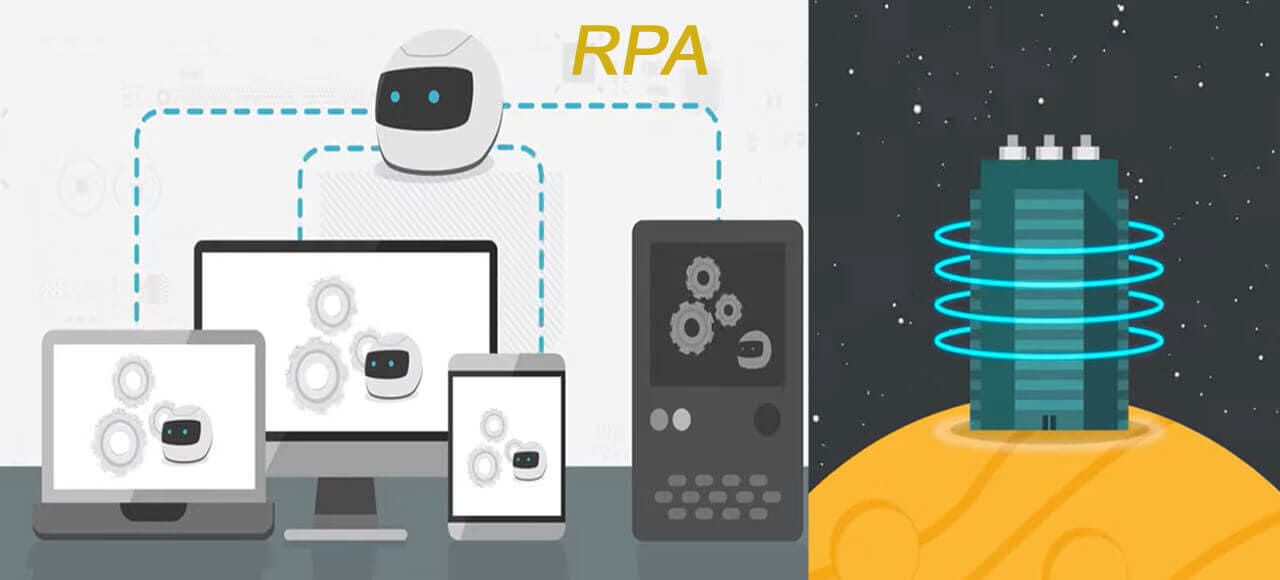Robotic process automation (RPA) is a technology that duplicates how people interact with software to carry out repetitive, high-volume operations.
Using RPA technology, software programs or “bots” are developed that can log into applications, input data, compute and finish tasks, and replicate data across applications or workflows as necessary.
What is robotic process automation (RPA)?
Robotic process automation (RPA) is a technology that duplicates how people interact with software to carry out repetitive, high-volume operations.
Using RPA technology, software programs or “bots” are developed that can log into applications, input data, compute and finish tasks, and replicate data across applications or workflows as necessary.
When used in conjunction with AI (Artificial Intelligence) and machine learning, RPA can extract more context from the content it is working with by using optical character recognition (OCR) to read text or handwriting, natural language processing (NLP) to extract entities like names, invoice terms, or addresses, and more.
For example, RPA can extract more context from images by automatically estimating accident damage in an insurance claim picture.
RPA is becoming more and more popular as a result of its ability to save costs, simplify processes, and improve customer experiences.
Another benefit of RPA software is that business units may use it without needing to learn new technologies, contact IT staff for assistance, or alter the foundational IT architecture of a company.
However, as RPA has gained popularity, businesses are realizing how important it is to include RPA process automations into their IT systems.
Bots may malfunction when application interfaces or process workflows change, despite the fact that RPA automations can significantly speed up a business process that was previously handled by people.
Modern RPA technologies reduce breakage issues by using AI, machine learning, and natural language processing.
It is simpler to grow the usage of RPA throughout the company with the help of modern RPA platforms, which also provide some integration with centralized IT governance and management capabilities.
Function of Robotic Process Automation
Robotic process automation mimics how users are used to interacting with and contemplating software programs.
RPA’s appeal is due in part to its ability to mimic how people carry out computer-based processes, as opposed to automation techniques like application programming interfaces (APIs) or low-code development that are more scalable but less user-friendly or need specialized expertise.
The most basic RPA bots may be made simply capturing a user’s clicks and keystrokes while they use an app.
When issues arise, a user just has to observe how the bot is interacting with the app to pinpoint the steps that need to be adjusted.
In reality, these simple recordings are often used as a model for creating more adaptable bots that can vary their layout, screen size, or process.
The layout and icons on the screen are interpreted by more advanced RPA tools using machine vision, which then makes the necessary alterations.
Some RPA technologies may also utilize these preliminary recordings to build hybrid RPA bots, which begin by just recording an existing process and then dynamically generate a workflow automation at the end.
These hybrid bots benefit from both the scalability of native process automation and the ease of RPA creation.
In other RPA deployments, business process processes are automatically captured using task and process mining tools, which are then utilized as starting templates for RPA automations.
In order to automatically create a map of typical business processes, process mining, for instance, may examine the logs of CRM and ERP programs.
Tools for task mining combine locally running applications with machine vision to record user interactions with several apps. These types of process mining connectors are now being developed by all of the main RPA providers.
Intelligent process automation is achieved by combining RPA technologies with AI modules that offer features like OCR, machine vision, natural language comprehension, or decision engines.
These skills are sometimes included in cognitive automation modules that support best practices for a certain sector of the economy or business process.
Who use Robotic Process Automation (RPA)?
The majority of sectors employ RPA, especially those that involve repetitive processes like telecommunications, banking, insurance, and finance. The following list includes some of the most popular RPA applications:
Customer service: By automating contact center duties like e-signatures verification, uploading scanned documents, and information verification for automated approvals or rejections, RPA enables businesses to provide better customer service.
Financial services: Organizations in the financial services sector utilize RPA to handle insurance claims, manage audit requests, automate account creation and closure, and make foreign currency payments.
Health Care: RPA is used by medical institutions to handle patient data, claims, customer service, account administration, billing, reporting, and analytics.
Supply chain management: RPA may be used to automate order processing and payments, track shipments, keep an eye on inventory levels, and make purchases.
Problems that PRA Face
Nevertheless, utilizing robotic process automation has certain drawbacks in addition to all of its advantages. What are they, exactly? When carrying out your own PRA, keep these in mind.
Short-term Results Achieved by RPA: RPA solutions provide advantages for easy adoption and enhanced user experience. We can gain from this and it can be done for short-term problems.
However, obtaining long-term success necessitates using intricate Omni-Channel systems and regular process assessment and adjustment.
Lack of Capability: Although the RPA tools now on the market are highly sophisticated, machine learning capabilities are still somewhat constrained.
When AI and machine capacity are coupled with RPA technologies, the full potential of automation will be made feasible.
Ownership: Who is the owner of RPA solutions? RPA design involves several steps.
The project criteria must come from the company, IT teams must develop the program, solutions must be assessed for viability, and user acceptability testing (UAT) must be carried out to estimate the success rate.
IT teams only have a little part to play, which is mostly confined to creating test data and supporting infrastructure.
Change management: Once RPA scripts are in production, business and IT teams must work together and proactively provide them system and business changes so that they can be updated.
Using numerous programs in the procedure might make them more difficult. Any modification to the front-end UI will alter the RPA script and the result.
Employee On-Boarding and Resistance: This is one of the major issues facing businesses since, by their very nature, individuals are resistant to change.
Employees may feel anxious about any changes that come with implementing a new technology since their roles may alter.
Successful adoption depends on frequent communication from business executives and executive sponsors to make sure staff members are fully aware of what is expected of them throughout the implementation process.
The adoption of this strategy and the removal of behavioral barriers will both be accelerated by fostering an innovative culture inside the business.
How to choose RPA software?
Enterprise executives should take into account the following factors while searching for RPA technologies:
Scalability. Instead of deploying and scaling RPA on each desktop, businesses are recommended to use RPA systems that can be controlled and scaled centrally from a single control panel.
Speed. In a few hours or less, businesses should be able to build and test new robotic procedures while also speeding up the bots’ performance.
Reliability. Companies should seek for technologies with built-in monitoring and analytics so they can keep an eye on the health of their systems as they introduce robots to automate hundreds or even thousands of manual operations.
Simplicity. Businesses should seek for solutions that are simple enough for staff members to construct and utilize them for a variety of tasks, such as data collection and converting material into information that helps executives make the best business choices.
Intelligence. The finest RPA solutions can read from and write to any data source, enable basic task-based activities, and use more sophisticated learning to further automate tasks.
Enterprise-class. Businesses should seek out technologies with enterprise-grade scalability, dependability, and management from the bottom up.
Governance. To assist manage bot security credentials, evaluate any privacy concerns, and identify any problems, enterprises need to take a close look at the different security and governance capabilities.
Preparing for finances. Teams may evaluate the return on investment of current bots and rank chances for future automation based on expected value with the use of tools for tracking bot usage.
Hyperautomation will be the market driver for RPA in the future.
According to a Global Industry Insights Inc. research, the RPA market is projected to grow to $5 billion by 2024.
The predicted rise of RPA is mostly due to the rising use of RPA technology by companies to improve their capabilities and performance and promote cost savings.
Although RPA has gained popularity due to its ease of use, businesses have had trouble scaling deployments. According to Gartner, hyperautomation will eventually speed up RPA’s expansion.
RPA-based hyperautomation projects integrate RPA with additional automation technology, including as decision engines, low- and no-code development tools, and BPM tools.
It will be simpler to include AI capabilities into these automations with the help of IPA and cognitive automation modules.
Finding new automations will be aided by process and task mining. Enterprises may manage the whole process of simplifying operations in ways that assure trustworthy AI with the use of other AI governance technologies.
Companies will need to have a systematic framework for locating and developing automation possibilities, as well as managing the whole process throughout the company, as hyperautomation takes root.
To manage and scale automation initiatives, several firms have created an automation Center of Excellence.
According to Forrester study, the combined effect of these numerous automation technologies might assist businesses in saving $132 billion in labor value in the U.S. alone.
What are the advantages and disadvantages of RPA?
While RPA has many advantages for businesses, it also has certain disadvantages. These are the top eight benefits and the top five drawbacks of RPA, according to experts, for enterprises to think about.
Robotic process automation was identified by PSCU, a credit union service corporation with headquarters in St.
Petersburg, Florida, as one of the solutions that may help it expand. It created a comprehensive RPA strategy as a result, selecting Nice for its automation software and consulting expertise.
PSCU, which put its first bot into use in September 2019, currently uses RPA to handle four back-office tasks, according to Molly Walker, the manager of business excellence in charge of the organization’s RPA center of excellence.
According to Walker, the firm presently has “a lengthy list of use cases in the pipeline,” and the technology is not only assisting PSCU in keeping up with its expansion but also providing additional advantages.
It is evident that automation is increasingly being used by businesses across all sectors.
By 2022, 90% of big enterprises worldwide, according to Gartner, will implement RPA in some capacity, and by 2024, they will have tripled the capacity of their current RPA portfolios.
Business executives and experts said that RPA’s advantages are what are fueling this expansion. RPA may have drawbacks, they said, especially when businesses don’t think carefully or strategically about the automation initiatives they embark on.
For CIOs and other IT executives to think about, these leaders presented the list of RPA’s advantages and disadvantages below.
Advantages of Robotic Process Automation (RPA)
Advances in efficiency. RPA is able to do jobs more rapidly and less expensively than humans.
As a consequence, businesses may anticipate productivity gains without experiencing the corresponding cost increases that would have happened if they had employed more employees to do the same amount of work in the same amount of time.
“That’s simply how bots work; unlike us humans, who require breaks, computer code works 365 [days], 24/7.
It’s challenging to compete, “added Tony Abel, managing director of Protiviti’s supply chain solutions practice and RPA lead.
Decrease in mistakes “Computers follow instructions. They don’t commit as many mistakes as people do sometimes, “RPA software also offers a thorough audit trail so that businesses can understand what was done when, Abel said.
Heightened agility Ken Weilerstein, analyst and consultant at The Analyst Syndicate, noted that RPA often makes it easier for a company to adapt to changes in business processes.
Instead of asking IT personnel to set aside time and resources to modify the underlying business systems, which is often a more time-consuming, difficult, and expensive operation, workers can frequently make rapid alterations inside the RPA program, which tends to be lightweight and adaptable.
Similar to this, new RPA deployments or updates to existing bots come with a lesser risk of interruption or unexpected repercussions since robotic process automation is stacked on top of corporate systems rather than being embedded within them.
RPA gives enterprises the opportunity to allow quick process alterations, thus enhancing their agility.
Better utilization of human resources. According to IT advisers and management executives, RPA often helps firms to refocus employees’ attention from low-value jobs to higher-value ones that improve customer experience and eventually boost revenue development.
Walker saw this change in her own business and stated: “RPA helps us expand by allowing our staff to conduct value-added work.”
For instance, customer support agents used to spend a lot of time obtaining and entering information for rate modification requests.
This reduced the amount of time they could spend having direct, consultative talks with clients.
However, RPA bots now take care of that data collection and keying, according to Walker, providing employees more time to speak with consumers directly about how PSCU services may be able to satisfy their requirements.
Simply said, RPA allows employees to spend more time providing advice to clients rather than copying and pasting.
Increased involvement of the workforce. Workers may devote more of their time to more useful work since RPA bots handle the repetitive, and sometimes boring, duties inside the organization, according to Abel. This often results in employees who are more engaged at work.
Increased client satisfaction. Abel claims that consumers might gain from businesses automating operations since it can provide for a quicker and better experience.
A bot, for instance, may access and download data to respond to a client’s query instantly, negating the need to ask the consumer to wait.
Process standardization. According to Kevin Martelon, a process consultant and automation partnership manager at Saggezza, a worldwide IT consulting, even when businesses improve their processes, they can seldom guarantee that the human workers follow the instructions exactly every time in every office location.
Sometimes certain personnel in various areas modify the procedure to their own preferences. RPA, on the other hand, completes tasks precisely as instructed, ensuring that a procedure is applied uniformly across locations at all times.
Help for business continuity Building bots that can do activities traditionally performed by outsourced services in the event that such services go offline is one way that organizations may utilize RPA to enhance their business continuity (BC) strategies, according to Martelon.
He said that, even if the bots aren’t called into action, their existence may help firms reach BC targets as mandated by legislation or their insurance policies. “RPA can operate as a backup; it’s like purchasing a generator,” he said.
Disadvantages of Robotic Process Automation (RPA)
Attrition. RPA bots sometimes replace employees, although it is a possibility. Additionally, firms won’t need to recruit extra people to manage the expanding amount of work since they may deploy bots to handle the workload growth.
“Vendors promote the idea that robotic process automation reduces monotonous and superfluous labor, but in fact, such tasks were performed by humans for pay.
Therefore, work is being eliminated, along with jobs and hours “said Weilerstein. “It’s a serious concern for individuals, and it also affects corporate perception.”
Expansive technology Organizations run the danger of building an unmanageable collection that is increasingly difficult and expensive to manage as they add more bots to carry out more activities.
Abel emphasized the necessity for good governance and a successful RPA center of excellence, saying, “That may happen if you’re not controlling it appropriately, if knowing who has responsibility for what isn’t established [and] if you’re simply producing bots and pushing them into production.”
More complexity RPA may accomplish the same thing if it is not properly documented, controlled, and regulated, according to Weilerstein. It adds complexity, which can make it more difficult to accomplish business gains.
“Businesses can easily adapt to changing business processes thanks to RPA, which allows them to do so piecemeal rather than systematically upgrading the software.
The issue with it is that it makes it hard to troubleshoot to determine what went wrong, “added Weilerstein. The complexity of the total image is increased by the layers.
Problematic processes are amplified. Organizations that automate processes without first reviewing them and, if required, reengineering and optimizing them run the danger of automating problematic processes, according to experts.
This entails enhancing inefficiencies, mistakes, and everything else that was initially problematic with the process. Additionally, it introduces additional risks and expenses that may cancel out any anticipated ROI.
Thwarted transformation. According to Martelon, executives who see RPA as a tactical, point-by-point solution rather than a tool that is a part of a comprehensive plan would find more restricted advantages.
Enterprise executives must have a strategy plan for prioritizing their automation initiatives and understand how those projects fit into their larger strategic visions if they want RPA to help their digitization goals.
Conclusion
Robotic Process Automation technology is being used more and more in company operations to complete time-consuming jobs.
Automation may be deployed in any industry where such activities can be validated since RPA software frees workers from manual labor.
Businesses may ensure a greater ROI by using robotic process automation, which will help them in the long term.
I hope, you are now clear about robotic process automation (RPA) after reading this blog. Now, its time to share your experience and opinion about this trending technology robotic process automation.
Recommended articles:
What is Blockchain? How to become a blockchain developer and what to learn?
What is Edge Computing? Advantages and disadvantages of Edge Computing
List of top 30 latest technologies | Best trending technologies
Artificial intelligence | types, categories, applications, examples and goals of AI technology
What is data science? All you need to know about data science
What is cloud computing? Types, advantages and disadvantages




